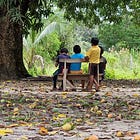But now I couldn’t see anything. Had it gone dark? Had I gone I blind? No, neither, there was something covering my face. I could feel it. I reached to remove it, but my arms wouldn’t move. I struggled. Thrashing against the restraints. I couldn’t breathe. Something was weighing me down. So heavy. The darkness itself was so, so heavy. Crushing me. I couldn’t…
I wake up with a gasp and my heart pounding. Remnants of some dream or other scattering away from my consciousness like cockroaches when the light goes on. Something…with…maybe fish? None of it was real. None of it…except the heavy weight on my chest. I rub my sweaty hair out of my face and look down. I must have fallen asleep breastfeeding my toddler. In a hammock, even a one-year-old can feel like quite a mass. I gently shift her to my side, trying not to wake her. I take a deep (and strangely reassuring) breath and look around.
Everything is slow in the afternoon heat. There’s a pile of turtles on the log in the pond, their bright yellow heads gleaming in the sunshine. A young mango tree nearby is rocking in the breeze. There are dragonflies…hang on a second. There isn’t any breeze. What’s going on with that tree?
Thunk. Thunk. Two hard green mangoes hit the ground. Seconds later, with a flurry of leaves and bits of bark (and happy shouting) my son and his friend scramble down the tree after their prey. She pulls out her pocket knife and cuts the peel of his and then her own. The flesh is hard and pale green. I knew from a prior moment of curiosity that it was also mouth-puckeringly sour, but they devour them with every evidence of great enjoyment. Snack time is very important to them. I can hear the crunching from here.
What do our bodies need?
Snacking’s a polarised concept in Western health: We’re told that toddlers must eat every 2-3 hours lest they waste away, but for adults snacking is utterly terrible. Or completely vital to prevent the dangerous decline of blood sugar that leads to illness, fainting, and divorce. It depends who you ask.
So where does the scientific truth lie?
In the middle. It almost always does.
Our anatomy suggests that humans have evolved to eat intermittently rather than graze continually: we have a gut with a stretchy stomach that then feeds into a narrow small intestine. And our physiology agrees: building a gallbladder is only worthwhile if you're expecting lots of food occasionally (which is why plenty of continually grazing animals like horses don't have them). And we know that occasional fasting is good for systemic metabolic health.
But, on the flip side, our stomachs are a lot less stretchy (and our gallbladders relatively smaller) than specialist intermittent eaters like wolves. And, if we look at the best evidence (in this case the recent ZOE Predict study), we see that, outside of occasional fasting, snack frequency isn’t correlated with worse metabolic health.
Well that's not very helpful. However, the ZOE study found that the health effect of eating timing depended on what had been eaten. So perhaps to better understand snacks vs. meals we should pay less attention to the timing, and more attention to the food?
We’ve lived in cultures where the concept of regular meals was introduced within living memory. Prior to that, the timing of eating was allowed to depend on only two things. Without cold storage, processed food, or ant-proof Tupperware, people ate when two things coincided: enough work/luck to get food, and enough hunger to bother trying. Catch a big fish and you'd eat well, having your next food a day or two later. Catch a small squirrel and you'd be off picking berries a couple of hours later. We put in more effort to find food when we're hungry.
Both the quality and the quantity of the food fluctuated with the seasons, and the gaps in between eating ranged from minutes to days. Not many animals are built to deal with that sort of dietary variability as well as humans. We should be very proud!
(Nb. Babies, although still more robust than most mammals, aren't quite as tough as the rest of us. Luckily, they don't have to be: lactation means that mothers can buffer the intermittency of food by providing milk on demand. But even here hunger correlates with effort. Babies signal hunger (as you may have heard first-hand, if you've been within 1400m of a baby at any point) and those signals drive milk production, which then employs the mother's appetite to find more food).
So. How much you want food dictates how hard, importantly how often, you’ll work for it.
For children to learn how to work harder for food (either by going to find food, or by eating food that is less palatable), they therefore need to experience wanting food. Or, as we usually call it, hunger.
What’s the problem?
The problem is that WEIRD cultures (i.e. those that are Western, Educated, Industrialised, Rich, and Democratic (although ‘Despotic’ is making a strong play for inclusion in the acronym)) are currently experiencing a chronic and dangerous shortage of hunger.
Just as children raised in poverty can slip into reflexive hoarding when they get their own homes as adults, our culture still remembers overcrowded cities and starving street kids and now we can have access to food continually, we reflexively overdo it.
The phrase ‘I'm hungry’ from the lips of a child is so taboo in our culture that we put them on a strict scheduled routine of meals and snacks every 90–120 minutes. Whether or not they are hungry, they are given foods that they want to eat. The terrible phrase can't escape if their mouths are full!
The thing is, the body is smarter than we are. It knows it doesn't need food at this frequency, so it dials hunger all the way back. As a result, motivation to eat drops and we have to invent ever more palatable food to coax unhungry mouths into action. It's that or a funnel.
Inventing palatable foods shouldn't be a problem. We've done that for thousands of years! However, the industrial revolution tested the limits of human economics and found that if you feed humans three large meals a day, you can squeeze maximum productivity out of them. Where industry led, the military followed. That's it. That's why our culture swears by three nutritious meals a day. It's a productivity argument, not a health one.
And once people are sure they’re getting all the actual nutrition they need from three ‘meals’ during the day, then they don’t really have any expectation of getting real sustenance from anything else. These new ‘snacks’ (i.e. anything that doesn’t fit into the WEIRD categories of ‘Breakfast’, ‘Dinner’, and ‘Tea’ (adjust meal names for your country of origin)) are free to become whatever is most palatable and lowest effort.
Which is where we start to see problems. The logic goes like this:
For a number of reasons (including production constraints, ingredient cost, palatability profiles, shelf stability, and more), actual nutrients make snacks less profitable. So, thanks to no-holds-barred market competition, most child snacks now have very little nutrition other than calories of energy.
If children eat a lot of snacks, they displace healthier foods from their diet (because, clearly, they aren’t hungry enough to drive any effort, and eating nutritious meals (especially learning to eat nutritious meals) involves a degree of effort).
And children do eat a lot of snacks (US preschoolers now get more than a quarter of their daily energy from otherwise almost-nutrient-free snacks).
And this lack of nutrients has an actual effect: One-year-olds who have a dietary pattern labelled as ‘snacks, processed food, and sugar’ even have smaller brains at age 10; rates of scurvy in US children have more than tripled in the last ten years, and the UK government’s National Diet and Nutrition Surveys show that in our snack-happy nation, our children have problematically low levels of iron (builds blood and immune system), magnesium (important for metabolism), and iodine (helps cleaning kitchen tables, but also critical for growth and brain development).
In summary, we were so scared of kids going hungry that we invented a way to keep them eating by effectively feeding them nothing. In doing so, we unleashed a form of Western malnutrition and permanently decoupled WEIRD kids’ eating behaviours from the guidance of hunger. Go us!
What can we learn from traditional cultures?
In 18 months living in traditional cultures, neither of us ever saw a parent whip out a pouch, bar, or bag of snacks for a toddler. The major reason for this was the ubiquity of breastfeeding. Most non-WEIRD toddlers are breastfed on demand. And, despite the WHO recommending breastfeeding up to 2 years, most WEIRD toddlers are not. To be clear, there’s no blame attached to parents here. This is not their choice: our culture of 9–5 jobs, nuclear families, paid childcare, and taboo around feeding older children makes it nigh on impossible.
If mum, or a willing alloparent, wasn’t available in the villages we lived in, there was usually some fruit or a piece of hard cassava bread for the youngsters to suck and gum. Despite putting in hours of concentrated effort, littler children didn’t really get very far with these, but there was no panic about that. The snacks were intended to fill up time, not bellies. Possibly, when people have firsthand experience of energy malnutrition (what we might call starvation if it were severe), they are less intimidated by the risk of it magically appearing, unexpectedly, mid-afternoon?
On the other hand, older children, all over the world, are expected to find their own food if they are hungry at a time the family isn’t cooking. When we saw this it clearly reflected what their family had eaten recently. If you saw a woman getting out the big pot in the evening, then you wouldn’t see her kids out with a slingshot and a purposeful look in their eye the day after. Snacking and hunger coupled together perfectly.
These kids (and their resulting adults) were snacking when their metabolisms needed them to, and nearly always on something more nutritious than anything you could find in a WEIRD supermarket’s snack aisle. However, that’s not because they or their parents were having to exert willpower or restrictive rules - this is just what it looks like when people have been allowed to learn how to understand their bodies’ signals and act on them. And crucially, when their food environment means that the choices that were best for their health are the choices that were easiest to make.
What should we do?
Ok, so, utopian restructuring of the West’s food supply systems aside, what can we do?
Three principles of snacking
Make snacks more effortful: Real hunger produces effort. A good way to check if someone’s hungry instead of just bored is whether they’ll work for it. The challenge doesn’t have to be a big one:
Small step - don’t provide snacks unless you’re asked. (Remember that young children often can’t articulate hunger, and it’s fine to give them food if you think they need it. Just consider the list of reasons that a child might misbehave other than needing food.)
Bigger step - get them to sort out their own snacks, or better still, forage a snack.
Make snacks more nutritious: Kids want snacks for various reasons. Hunger, distraction, entertainment. Let’s capitalise on that motivation and make sure that snacks are going to be a net nutrition gain, not a loss.
Make snacks less delicious: Very palatable foods (especially those that have had millions of pounds spent on their development) override our ‘fullness’ signals, which means we keep eating not because we’re hungry, but because we like the sensation. If you want children to be able to calibrate their food intake and still eat meals, don’t make snacks too tasty.
What does this look like in practice?
Make snacks more effortful
Breastfeed as long as you can. It’s not just about their health and nutrition too - it gives mothers a way to instantly reassure, soothe, and comfort toddlers, and it’s a sure-fire way of helping tired toddlers to nap. And it takes effort. In any breastfeeding session, babies stop working to get milk out of the breast when the effort of breastfeeding is greater than their hunger or thirst.
Get children to ask for a snack if they are hungry. Don’t provide snacks if the child’s not asking and not behaving as though they need food. Let children learn to listen to their bodies.
Suggest children forage for their snacks. We have a nearby park with a herb garden, and ‘herb snacks’ were a staple when we visited. Similarly, in the UK, from June until October at least, there are plenty of wild foods for children to find. Dandelions, mallow leaves, hawthorn leaves, serviceberries, plums, apples, and blackberries grow throughout most major cities and all over rural areas. Be careful near farmed/sprayed fields, but you’ll probably be ok elsewhere.
Make snacks more nutritious
Provide snacks that are more nutritious than meals. Avoid fruit for snacks - this will mean children are much more motivated for it (and you can then use fruit instead of sweets as a treat).
Handful of nuts or seeds - Prechew them a lot for babies, prechew them less for small children and supervise their consumption by slightly older children. This will also help reduce their risk of allergies.
Raw sweet potato - More energy than raw carrot, and with a delicious nutty flavour.
Small bowl of frozen peas - Have you ever met a child who preferred hot peas to frozen peas? They are few and far between. Both make great snacks
Carrots, cucumber, and other standard raw crudites. Think your child doesn’t like lettuce? When it’s in a hard-to-open box in a playground, and is the only option available, they may have a whole different perspective.
Make snacks less delicious
Don’t provide delicious snacks unless you don’t mind children missing the next meal - these drive overconsumption and reduce the child’s ability to decide when they’ve had enough.
If you have a drawer of processed snacks and you’re feeling ready to make a radical change, just dump the lot and never replace them. You’d be doing them a huge favour (for clarification, this is the sort of huge favour that gets you shouted at a lot at the time). These snacks drive overconsumption, decoupling hunger from eating, and preventing kids ever learning how to listen to their own hunger signals.
Look, don’t be scared of hunger. Humans are very good at not eating. Heck, there was even this one guy who ate nothing for an entire year and survived (Angus Barbieri - see below). Older children are perfectly able to go without food for a period of time. Many Muslim children during Ramadan fast from the age of six or seven without ill effects. And this has some useful consequences - it helps them to understand that hunger is manageable and controllable, and it motivates them to eat well at the next meal.
Everyone has a secret fear that their children won’t have enough to eat. That’s true in any culture. But in our Western food environment, that fear is not justified. The overwhelming majority of children will get more than enough energy, but four out of five of them don’t get enough fiber. 90% don’t get enough fruit and veg. Even scurvy is making a comeback in kids in the US. Snacks are where we can make an enormous difference to a child’s nutrition and long-term health.
We just need to make snacks more nutritious and less delicious.
You may also like:
Prefer to listen?
Notes
ZOE Predict study: https://link.springer.com/article/10.1007/s00394-023-03241-6
Intermittent fasting and metabolic health: https://bmcmedicine.biomedcentral.com/articles/10.1186/s12916-024-03716-1
Children who eat more snacks and processed foods have smaller brains: https://pmc.ncbi.nlm.nih.gov/articles/PMC10232626/
Scurvy rates in US children” https://journals.lww.com/jaaosglobal/fulltext/2024/07000/the_troubling_rise_of_scurvy__a_review_and.12.aspx
Many UK children are deficient in key micronutrients: https://onlinelibrary.wiley.com/doi/full/10.1111/nbu.12071
Children snack more frequently: Piernas C, Popkin BM. Trends in snacking among U.S. children. Health Aff (Millwood). 2010;29(3):398–404.
Most child snacks have very little nutrition beyond energy.https://ijbnpa.biomedcentral.com/articles/10.1186/s12966-015-0268-3
Children who eat a lot of snacks displace healthier foods from their diet - https://cms.sightandlife.org/wp-content/uploads/2023/03/Double-Burden-Malnutrition-sightandlife.pdf#page=29
Fewer than one in five children eat five portions of fruit and vegetables per day. https://digital.nhs.uk/data-and-information/publications/statistical/health-survey-for-england/2022-part-1/childrens-health-and-health-related-behaviours
Angus Barbieri, who fasted for 382 days: https://en.wikipedia.org/wiki/Angus_Barbieri%27s_fast











I loved this. So relevant - everyone is obsessed with snacking and it drives me mad, pre school and nursery, if you go out and about parents always have snacks available. I felt like a terrible parent with my first as she wasn’t a great eater so I tried not to fill her with snacks (bf too). My second now is obsessed with snacks and we’ve had to change our diet (no crisps etc) but she waits until we meet her friends and then eats theirs! We do eat a lot of fruit I feel like it’s a bit late to not do that but some great ideas here.
The other obsession that I feel is unnecessary is the have a drink after 5 mins of exercise that we now have. I dont feel that our body needs that unless it’s incredibly hot.
I’d also be interested in your thoughts about mealtimes because three times a day does not work for us and I’ve always wondered what’s more natural.
Such a helpful reminder. Kids are often not snacking for fuel, but for feeling and entertainment. And when every snack are highly palatable and ultra-processed, it rewires their sense of fullness and satisfaction (and makes it less likely for them to like whole nutritious foods). Keeping snacks simple (and just tasty enough) helps preserve natural hunger cues and mealtime sanity.